FBN PHOTO GALLERY #1
FBN PRODUCTION CENTER
This page is a collection of various photos contributed by Marty Meltz, FBN staff engineer. Some of these pictures were rescued in 1978 when photos were being disposed of from the Glendale Production Center during a major house cleaning campaign.

PRODUCTIONS AT FAITH CENTER
Here are some additional production photos to what we have displayed elsewhere on the FBN web site. For more photos and information on the various FBN productions click here.
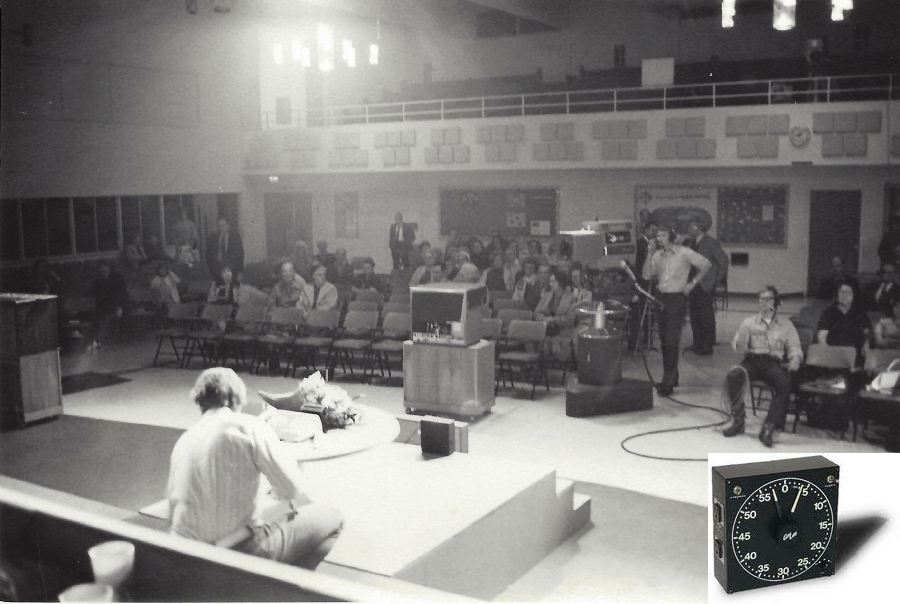


Pictured above is a still frame from the program Outreach Unlimited. Sitting at the right is the show host John Cardoza.
To the right is a photo of an early production taped in the Faith Center auditorium called The Late Great Planet Earth. The person sitting on the left is Prophecy Teacher Hal Lindsey. Seated to the right is the host of the program, Dale Kauffman. Dale was on the staff of KHOF-FM-TV. Standing to the right of Dale is Paul Calentine, Floor Manager for the show. This program was taped circa 1971.
This is a photo of a production that is about to begin in the Faith Center auditorium. While the date is not known it would be estimated to have been taken in 1973. The production is assumed to be one of the Thanksgiving Praise-A-Thons. This was determined by what looks like a cornucopia prop that is on the left side of the platform. You will notice a black square box at the center of the platform. That box is most likely the countdown “Pizza Timer” clock (actually a GraLab Photo Timer shown in lower right) that was often used during Praise-A-Thons to show time remaining during pledge challenges.
Behind the camera is Al Davis. To the right of Al on the front row is Don Johnson, Floor Manager. It is believed that Don Davis, Al’s brother, is in the foreground on the platform. Pastor Schoch is seen standing in the aisle to the far left above Don Davis.
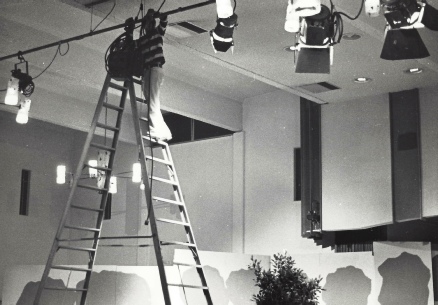

AT THE KHOF-FM STUDIO
This is a rare photo of the FBN Production Center being transformed from the former home of Glendale Hardware to a television production facility. This was taken on the first floor in the vicinity of what would be the future videotape room. On the right is the rolling door into the set/prop construction and storage area. To the left and behind the ladders will be videotape storage. Above the videotape storage room, with the stairs seen to the right, is the graphic artist area. To read about the construction of the Production Center click here.
KHOF-TV TRANSMITTER SITE ON SUNSET RIDGE
FBN taped a special program on New Year’s Eve 1976. This picture shows a production crew member on a tall ladder adjusting the lights for the production. The crew got very good at manhandling and quickly setting up that tall step ladder.


Looking south on a clear night from Sunset Ridge.
Another view to the southwest with the KHOF-TV tower in the foreground.
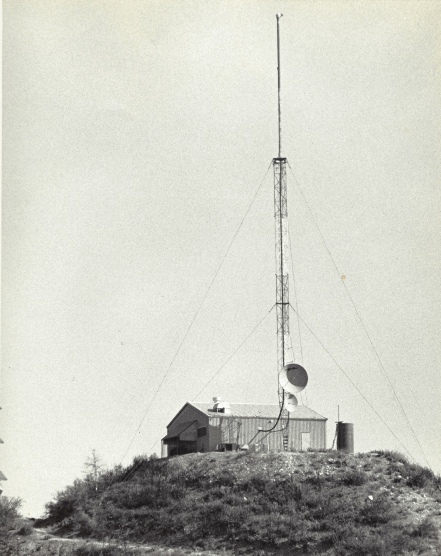
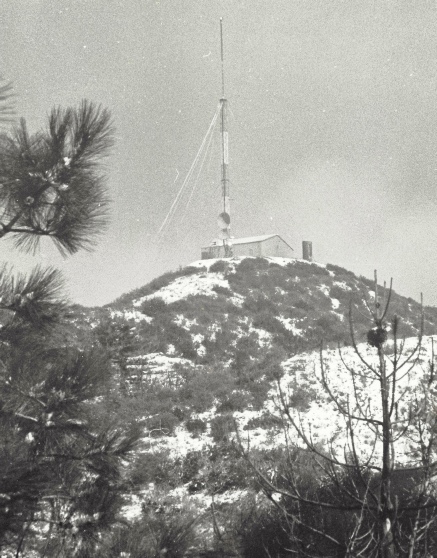
KSCI, Channel 18, was the second television station to be located on Sunset Ridge. This station was constructed circa 1976 and was built to the east in the saddle below the KHOF-TV transmitter which is where the photo on the left was taken. This photo was also taken during the winter.



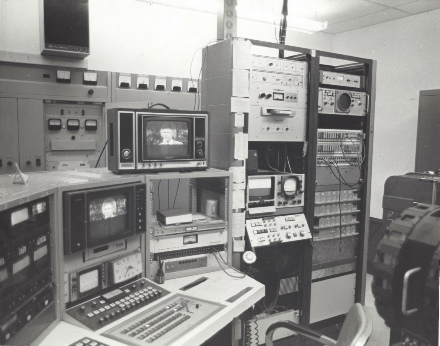
Pictures of the KHOF-TV Master Control area atop Sunset Ridge in front of the transmitter. These pictures were taken in November 1976. Click here to read about when the Master Control area was remodeled from the original installation to this newer higher tech version.
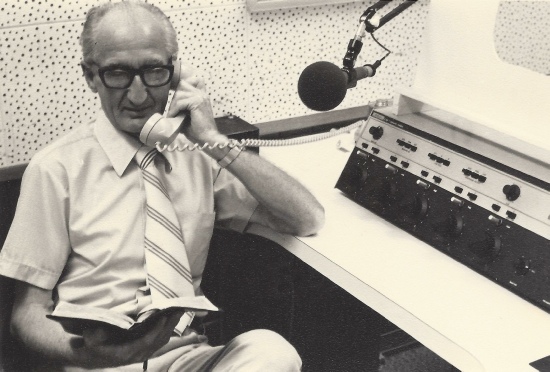

Above: Late night KHOF-FM radio host, Marcus Lehman, is on the phone with a listener. The radio hosts often counseled and prayed with listeners that called in.
Right: Daytime radio host, Ron Myers, selecting the next record of inspirational music he will play during his program. Note the turntable in the foreground.
INSTALLING THE KHOF-FM-TV TRANSMITTER MICROWAVE LINKS

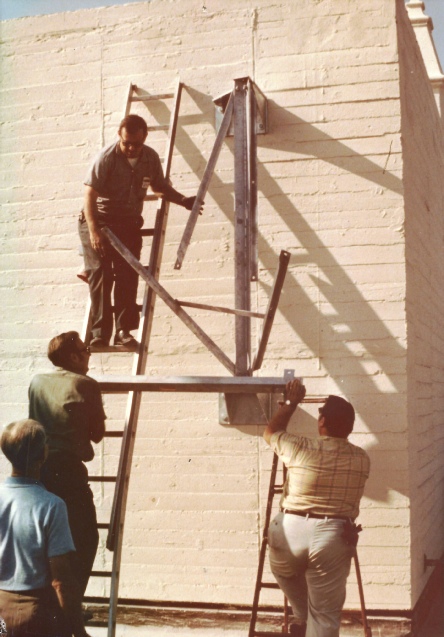

The 4’ microwave antenna mounted on the north side of the Faith Center main auditorium. The antenna is aimed towards a reflector on top of the Bekins Moving and Storage warehouse. This photo was taken not long after installation, circa 1970, as it has yet to be painted. The red lightning bolt is the logo of the Andrew Corporation, manufacturer of the antenna.
This is the reflector mounted on top of the Bekins Moving and Storage warehouse. This flat panel acts as a mirror to microwave frequencies. The KHOF-FM transmitter was blocked from view at Faith Center by the hills at Forest Lawn. This reflector located on Brand Ave. provided the means to “bend” the signal around the hills and towards KHOF-FM.
BUILDING THE LINK TO GET LIVE PROGRAMMING TO KVOF-TV
Assembling the reflector atop the Bekins building. Byron Mobus is on the ladder. Bernie Marston is on the left holding one end of a brace. Paul Calentine is on the right holding the other end. The person to the far left is Marcus Lehman.
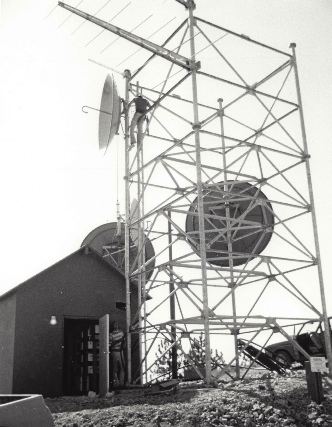



It took about six microwave hops on top of some tall mountains to get a signal from Los Angeles to San Francisco. The next hop after Oat Mountain and points north were the responsibility of American Television Communications (ATC). From Oat Mountain the signal’s next stop was Frazier Mountain. The photos above show the ATC wooden building and tower at Frazier Mountain. In the photo on the right you can see the tower worker installing what appears to be an 8’ dish type antenna to receive the signal from Oat Mountain. The Frazier Mountain fire lookout is seen to the right. One requirement at Frazier Mountain was that the towers and antennas could not block the view of the lookout. A senior couple manned the lookout 24 hours a day during fire season. They packed up and left during winter.
This photo is inside the building at Oat Mountain. It was a cinder block building with a wood 50 ft pole used as a support structure. The microwave antenna was mounted to the pole. Bernie Marston is seen looking at a picture monitor of the programming originating at the FBN studios. The FBN portion of the link towards San Francisco was now complete and operating. The map on the right shows the location of Oat Mountain and you can click on it to navigate for a closer look. Marty adds, “I remember that the Oat Mtn MW relay was located in a cinder block building just before the Nike X missile site near top of the ridge line. I believe it was the last building before the gate. It is either the building marked [on the map] or the site just above it. We mounted a 4' dish on a custom mount that Bernie manufactured on a wood phone pole mounted next to the building. About a year after the link was in operation during a winter storm in February 1978 we suddenly lost the link late one evening. The next morning Al Durban and I went up to the site to discover that the winds were so strong that the mount on the dish had broken and the dish was flapping in the wind. We had to bring in a mobile welder to fix the dish, later that afternoon.
To the right is Alex Valderam a making a station identification graphic for KHOF-TV
using a photographic process on a machine called a Staromat. Different fonts on film
were placed on the spools of the projector. The artist would make the lettering any
size desired and shoot them onto a special photographic paper on the table below
the projector. The paper was a special type that could be developed instantly to
reveal the lettering. The paper could then be placed on an art card for subsequent
televising using a TV camera.
a making a station identification graphic for KHOF-TV
using a photographic process on a machine called a Staromat. Different fonts on film
were placed on the spools of the projector. The artist would make the lettering any
size desired and shoot them onto a special photographic paper on the table below
the projector. The paper was a special type that could be developed instantly to
reveal the lettering. The paper could then be placed on an art card for subsequent
televising using a TV camera.
I asked Alex what he recalled and he said: I read my name and your question, I said to myself, what's a Staromat? I had to Google it to refresh my memory. The pic of me working on the equipment really helped me too. …I remember when first working at KHOF there was no art department to speak of. I was hired to start it and be the station's art director. For several months I had been using Letraset, a pressure sensitive font that was being used by Linda and other people that needed graphic title cards for productions. The so-called art department was a mess with miscellaneous sheets of Letraset scattered on a work bench. It was a long and tedious process using Letraset, and boy did I have to really work long and hard just to complete just one title card. Overall, it was not only long and demanding process, but each sheet cost a lot - I had to order more sheets than we actually needed. Sometimes, after we used a font style for a program title, we didn't use it again, so we were throwing dollars out the window; the shelf life was short too. If the adhesive side got dust or fell on the floor, it was ruined. For special projects, that needed a fast turn-around, I would call on The Title House in Hollywood. This company did titles for Hollywood productions... this was expensive.
So, I began to do research and found the Staromat. I called a rep and we were given a machine to use for a speculative order. I had gotten approval by Paul Crouch to have the demonstration. It passed with flying colors. And we were producing graphics for pennies on the dollar. From that time on, the art department was in real production. I could produce 6 to 12 graphic cards per day; and time enough during the week to design sets; and even operate camera, floor direct, and do lighting from time to time. This was a real plus for me when I left KHOF and moved onto PTL to develop the creative operations for the ministry.
Alex went on to add, “Please don't ask me about the 300mm telephoto lens I used with a Nikon to shoot Glendale landmarks for some of our station IDs. I think that was in Burt's department. I would borrow it from time to time. Learned a lot about photography from Burt and John Fleming.”
OTHER PHOTOS


Here is another angle of the lights being adjusted. Also seen are more crew members dressing the set. No, the crew members did not have super strength with the ability to carry around heavy boulders. Those were just rubber rocks.
The west side of the KHOF-TV transmitter building
Another view of the building looking northeast showing that winter had set in on Sunset Ridge
About Marty Meltz:
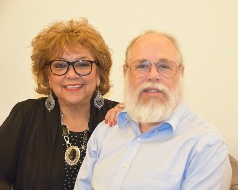 Marty Meltz graduated from Los Angeles City College with an Associate of Arts Degree
in Broadcasting Technology in 1974. After receiving a First Class Radiotelephone
license from the Federal Communications Commission He joined the staff of KHOF-TV
as one of the transmitter engineers in April 1975. In the spring of 1979 Marty left
the Faith Broadcasting Network, pursuing his career in the Television Post Production
industry in Hollywood. During this time he was a engineer specializing in videotape
systems, international television standards conversion, telecine and editorial systems.
He has designed and built several post production studios for the companies he worked
for. In 1998 as technology was changing he left the television field and went back
to school specializing in Information Technology. Marty earned a Bachelor of Science
Degree in Information Technology from the University of Phoenix as well as certifications
as a Microsoft Certified Systems Engineer, and Certified Novel Engineer. After he
completed his training Marty relocated to in central California worked in law enforcement,
non-profits, and specialized communications with an Internet service provider. For
the past 30 years Marty and his wife Raine have been involved with advocacy for Israel
and the Jewish community. In 2010 they moved to Israel to continue working with humanitarian
projects benefiting the Jewish community and new Jewish immigrants making Aliyah
from around the world to making Israel their new home. In June 2014 both Marty and
Raine became citizens of Israel, and reside in Jerusalem.
Marty Meltz graduated from Los Angeles City College with an Associate of Arts Degree
in Broadcasting Technology in 1974. After receiving a First Class Radiotelephone
license from the Federal Communications Commission He joined the staff of KHOF-TV
as one of the transmitter engineers in April 1975. In the spring of 1979 Marty left
the Faith Broadcasting Network, pursuing his career in the Television Post Production
industry in Hollywood. During this time he was a engineer specializing in videotape
systems, international television standards conversion, telecine and editorial systems.
He has designed and built several post production studios for the companies he worked
for. In 1998 as technology was changing he left the television field and went back
to school specializing in Information Technology. Marty earned a Bachelor of Science
Degree in Information Technology from the University of Phoenix as well as certifications
as a Microsoft Certified Systems Engineer, and Certified Novel Engineer. After he
completed his training Marty relocated to in central California worked in law enforcement,
non-profits, and specialized communications with an Internet service provider. For
the past 30 years Marty and his wife Raine have been involved with advocacy for Israel
and the Jewish community. In 2010 they moved to Israel to continue working with humanitarian
projects benefiting the Jewish community and new Jewish immigrants making Aliyah
from around the world to making Israel their new home. In June 2014 both Marty and
Raine became citizens of Israel, and reside in Jerusalem.
The microwave signal received at KHOF-FM was relayed east to the KHOF-TV transmitter. Pictured here is the crew removing a 10’ antenna to mount on the KHOF-TV tower. This antenna was receiving the signal from KHOF-FM 32 miles away.

A view of the east side of the KHOF-TV transmitter building with the truck parked at the entrance. When this picture was taken snow was blowing. A transmitter operator never knew what he would face when the shift ended and it came time to head down the mountain during a heavy rain or snow.


The truck pictured here was the replacement for a Toyota Land Cruiser after the Land Cruiser turned over in the mud. After a year or two of use the truck frame broke near the forward mount for the steering gear. The truck veered off the road just below the final turn out to the transmitters on Sunset Ridge. The truck sat there for about 4 months until it was pulled out with a small bulldozer. The people in the picture are Jim Costello pulling on the wheel with John Burrows and his dog. John was a transmitter operator for about two years from late 1977 until early 1979.

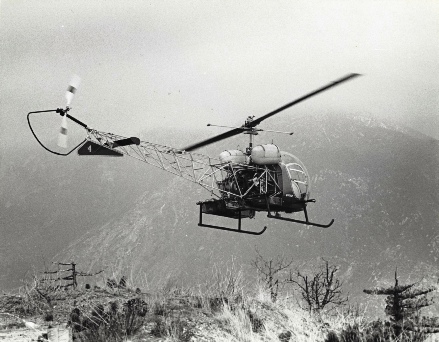
The helicopter pictures were taken in February 1978 after a large snow storm blocked the road. Marty Meltz is the person in the plaid shirt loading supplies into the helicopter. The other person was the pilot. It was six weeks before the road was clear enough to come down by vehicle form Sunset Ridge. The photo on the right shows the helicopter heading to back to port after leaving Marty on Sunset Ridge.
KIFM TRANSMITTER BUILDING
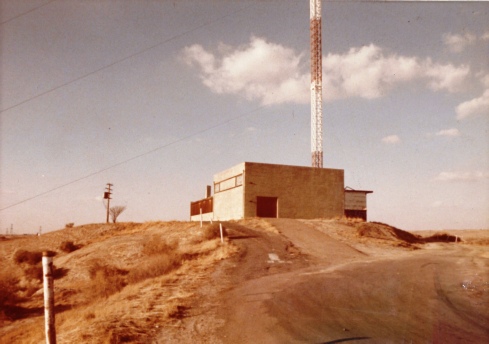
A photo of the KIFM transmitter building and tower at Oildale, California, 6 miles north of Bakersfield
On the left is another photo showing the Oat Mountain receive antenna installed on the tower. The image on the right is a Google map satellite view of the top of Frazier Mountain showing the location of the ATC building, on the right, and the Frazier Fire Lookout on the left. You can navigate the image or select a map view to see the location. You can also learn more about the FBN Studio to KVOF-TV intercity microwave link by clicking here. It is believed that an early radio relay link to KIFM may have been in this same building.
The WHCT Master Control room. Dr. Willard Peirce is shown on the monitors which is a playback of his teaching program “Christ The Living Word” produced at the FBN studios in Glendale, CA.
The exact location of this photo is unknown. Shown here is a film editor believed to be John Fleming editing a films for presentation using a device called a Moviola. John was on staff at KHOF-TV in its early days.